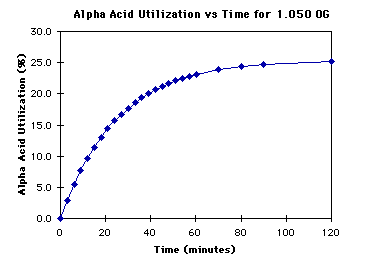From the research I've read the lower limit for IBU is around 15 . . . Oddly enough this is a level that is used in Budweiser . . . makes me wonder what the levels are in things like Bud Lite etc. :lol:
Now Upper limit, this is determined by a couple of things
Firstly the solubility of alpha acids is limited . . the boil turns them into Iso alpha acids which are more soluble. . . .so the boil vigour and duration are important.
Secondly iso alpha acids are broken down during the boil the rate depends on the amount of iso alpha acids in solution plus boil vigour, calcium levels etc etc etc this means that there is a plateau reached where the rate of iso alpha acid destruction is matched by the rate of iso alpha acid production. Which is what you can see on this graph from Glen Tinseths hop page

Thirdly is the upper taste perception threshold of the human palate, now this does vary from person to person, but has generally agreed to be around the 90IBU mark.
Now a couple of questions, can we brew a 200 or even a 400IBU beer? (one of the Durden Park IPA recipes uses 4oz of hops per gallon) . . . Here I am going to say that it is unlikely that we will
ever reach this
theoretical level. All the formulas for calculating IBU are flawed in some way, and using them with this hop rate is taking them far outside the zone in which they are intended to be used. The other factor is that while iso alpha acids are more soluble than alpha acids there is still a maximum solubility level that again will be well under the 'calculated' level.
This does raise another question, if there is a 1000IBU beer out there how did they do it? If it is an actual 'measured' IBU value rather than a 'calculated' one then it's quite simple . . .They cheated and added neat, chemically derived, iso alpha acids following the boil (and in fact probably following fermentation as high levels of iso alpha acids affect the stickiness of the yeast membrane and they flocculate early) . . . How would it taste . . . Bitter . . . but probably no bitter than a Hardcore or even a punk or possibly a Marstons Old Empire . . . remember we are WAY over the maximum taste threshold.
Is it worth brewing a beer with a high level of
theoretical IBU? I would say yes, if you like that sort of beer

, Many other flavours and flavenoids are extracted from the hops as well as alpha acids, and these all contribute to the flavour and hop profile of the final beer. Taking the Durden Park beer I mentioned earlier, firstly remember that these beers were casked for a year before being sent over to India via the Cape of Good Hope. During that time the bitterness would have been reduced, and the other flavour compounds all married together and the beer would have matured. It is surprising the complexity of flavour you get in a beer consisting of just pale malt and high levels of goldings hops, for bittering only, when it has aged for two years. (The high hop rate acts as a preservative and anti oxidant remember). Aroma is restored by dry hopping. The problem I have with these highly hopped beers when drunk young is that they all taste the same a massive citrus resin hit that just masks any other flavours, and is irrelevant of the variety of hops used. That resin flavour coats the tongue really preventing anything else from being tasted at all. . . . Can you tell it's not a favourite style of mine :lol:





